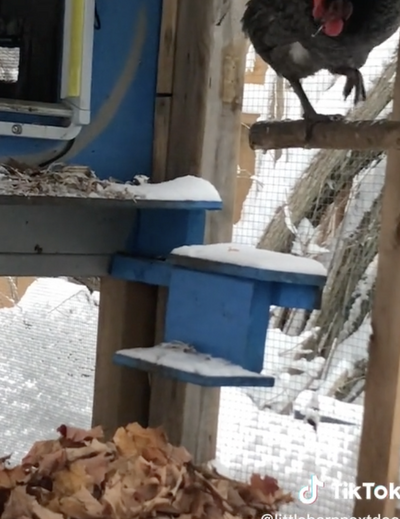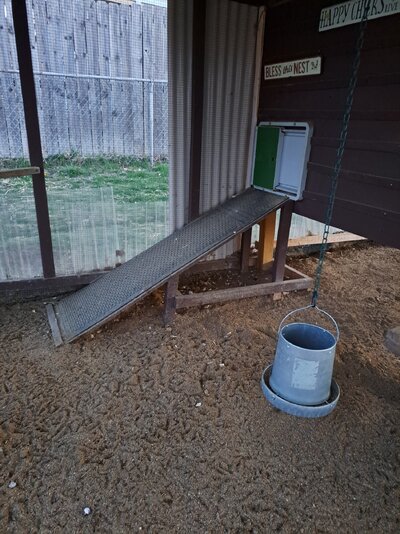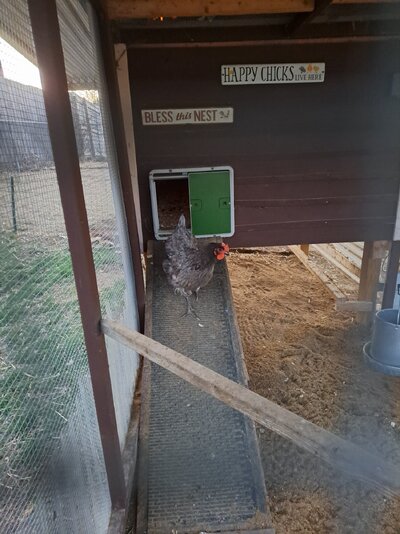Wonderful thorough and concise response and I fully agree with all of it!Yes, exactly. The main variable is the moisture content and thus whether the system is dry or actively composting.
One of the beauties of this system is that it doesn't have to be precise. If your coop/run don't stink then you're fine.
Probably.
You're looking at two things with ventilation, first, the replacement of warm, moist, ammonia-laden air with clean, fresh air -- which is why in my article you see vents at the top and bottom of the roof slope -- and, second, temperature control.
If your ventilation is sufficient to keep the temperature inside the coop equal to the temperature outside the coop then you're probably good on the fresh air part too.
The guideline is to have at least 1 square foot of permanent, 24/7/365 ventilation per adult, standard-sized hen. By experience I have found that in my climate if I don't have DEEP shade I have to have double or triple that to keep the coop under 100F on a 90F day.
You need to think about airFLOW, which is why I made the diagrams in the article I linked.
Put all the ventilation you can manage up right under the roof and you'll never have to worry about drafts. Have a look at my brooder, where I can have chicks who are less than week old outside in the winter with their heat source, 16 square feet of ventilation, but no drafts down on the floor where they are.

To comment on all these feed issues,
I do not move feed in and out and have not had a rodent problem in the chicken area. The hanging feeders I mentioned earlier limit the spillage that attracts rodents. I tried those spill-proof feeders and found my chickens unwilling to put their heads into a hole in order to eat.
If you are going to use that sort of feeder, be aware that rodents, including squirrels, can chew right through plastic. Also, depending on climate, it could be prone to condensation, which would cause the feed to get moldy -- very bad for the birds' health.
This is one of those areas where everyone's situation is going to be a bit different and thus each of us must determine what works for us in our situation rather than try to come up with a one-size-fits all solution.
Chickens are tough, adaptable livestock that are capable of doing well under many different management systems.
There are many, many different kinds of bedding that you could use, each with its advantages and disadvantages. Some are universally available, some are locally abundant but unavailable in other areas. Sometimes you get free bedding where the price makes up for any disadvantages it has.
Wood shavings -- universally available at a reasonable price, absorbent, somewhat resistant to packing/matting, light and easy to handle, slow to break down, may be dusty. Beware Cedar because Eastern Red Cedar contains aromatic oils that are highly irritating to the lungs and birds have delicate respiratory systems.
Straw (the stalks left over after harvesting grain) -- comes in bales or chopped and in different textures depending on which grain it was. Traditional animal bedding over millennia, absorbent, often inexpensive, composts readily, can be prone to packing/matting and thus may need to be fluffed up more often, may grow mold if it gets wet, hollow stems *might* (or might not), harbor parasites IF they are present (this is debatable). An intact bale with one string cut is an EXCELLENT boredom buster for a flock that has to be confined for some reason. Intact bales make excellent chicken-level windbreaks.
Sawdust -- fine and dusty. Fairly absorbent. Scoopable. May be available for free but be careful of the source to not get treated wood or Eastern Red Cedar. Easy to handle, composts faster than shavings but not as fast as straw.
Pelleted Horse Bedding -- Easy to handle, highly absorbent, may be expensive. Composts like sawdust because that's mostly what it is.
Wood Chips -- Coarse wood chips from a tree trimming service are generally considered the gold standard for controlling mud and odor in the run. Do not pack or mat. Highly absorbent. May be available free from a municipal waste site in variable quantities, may be available free by the dump truck load from a tree trimming service. Bagged mulch is similar but be sure to get it free of dyes and fertilizer and the coarse kind rather than the finer variety.
Hemp Bedding -- Trendy among the eco-conscious. Expensive. Scoopable. I have no direct experience with it.
Pine Straw (the long, soft needles from the Loblolly and/or Longleaf pines) -- Locally available in the US southeast. Inexpensive or free-for-the-raking. Not particularly absorbent. Highly resistant to packing/matting. Dries out on top quickly after even the heaviest rains. Very slow to break down.
Shredded Paper -- light, absorbent, may be free for the labor of doing the shredding. There's a long thread about it here: Using Shredded Paper for Coop Litter - As Good As Wood Chips?
Fall Leaves, Lawn Clippings, and other yard waste -- highly variable in availability and composition. May be excellent, may need extra management to keep it from packing and matting. Free. Uses material you would otherwise have to dispose of.
Ground Corn Cobs, Rice Hulls, etc. -- Locally available materials worth looking into if the price is right.
While the commercially available pine straw in the US Southeast comes from the Loblolly and Longleaf pines, any soft pine needle can be included in the "yard waste" category. I wouldn't use Spruce needles or anything like them simply because they're too sharp for me to handle comfortably.
An excellent point.
My climate and water source tends to grow algae so I don't use a giant system for that exact reason.
Also, with my large, mixed age, mixed sex flock it's better to have multiple water sources in case of flock bullying issues.
I have always loved your article and the chicken cartoons and I have exactly what you recommend in terms of ventilation.
I have to chuckle though, because I now have two chickens that insist on roosting on the rafters holding up the roof - I think they are perfectly placed in the only draft possible which is between the soffit vents and the roof ridge vent and facing the gable end top triangle vents. Silly girls!
I think they are fine and it probably isn't really a big draft except when it is very windy - but I always picture them in the little skirts and scarves of your cartoons being blown about while the roost provided is lower down and nicely draft free.
Turns out you just cannot control for the chickens and they will do what they will do!








